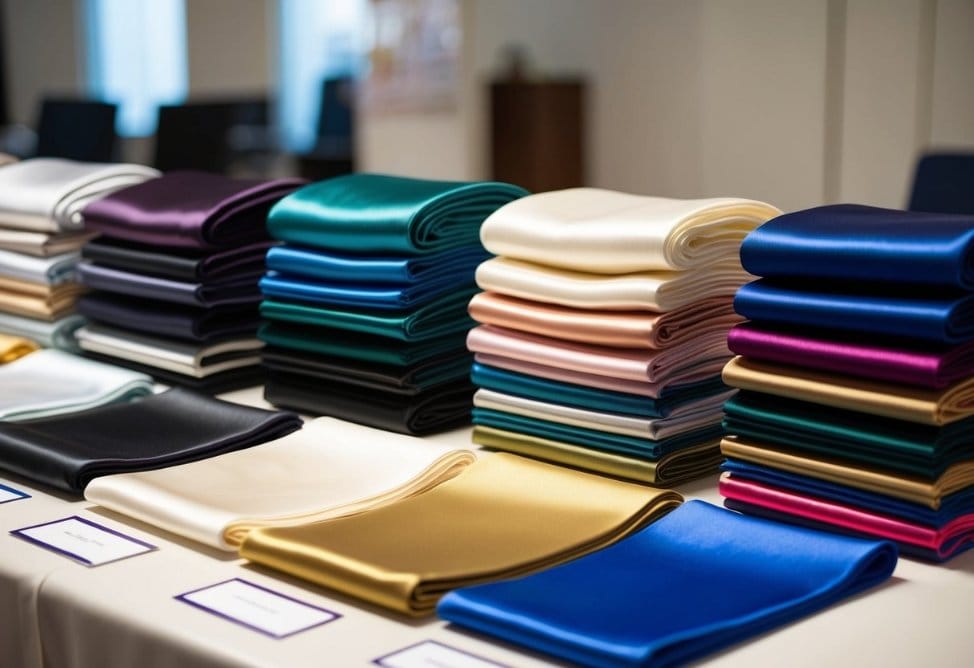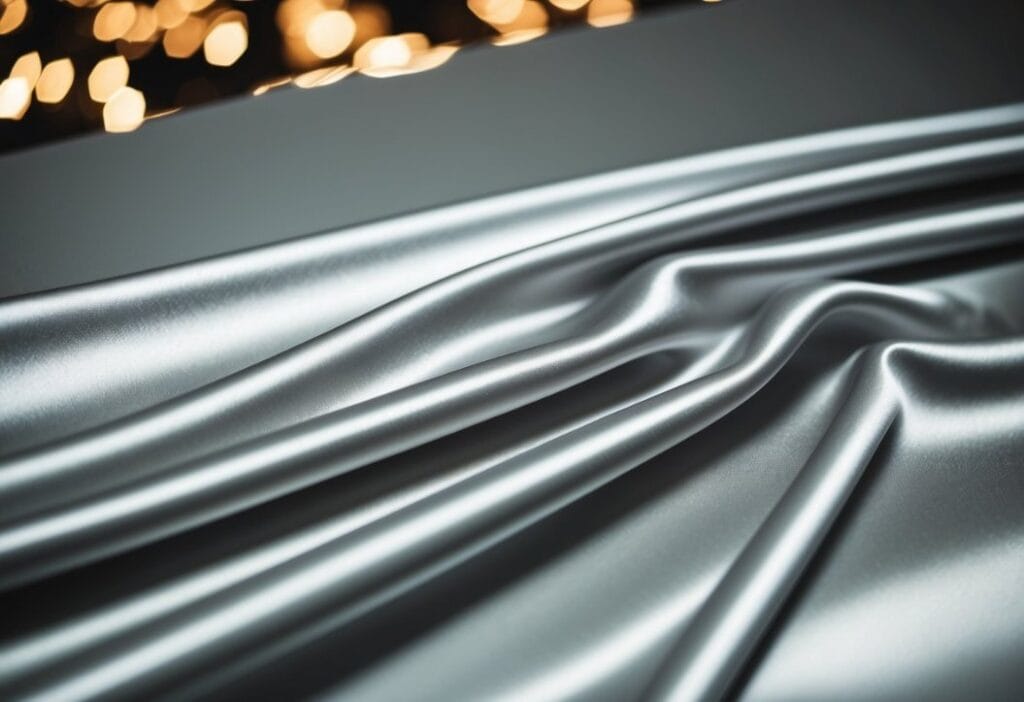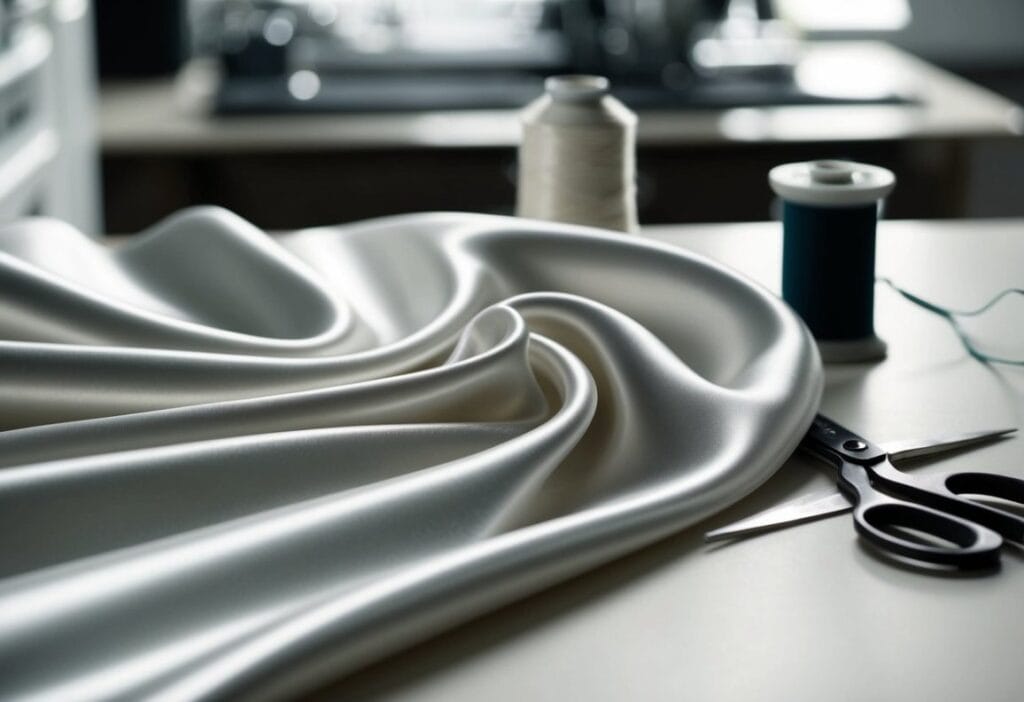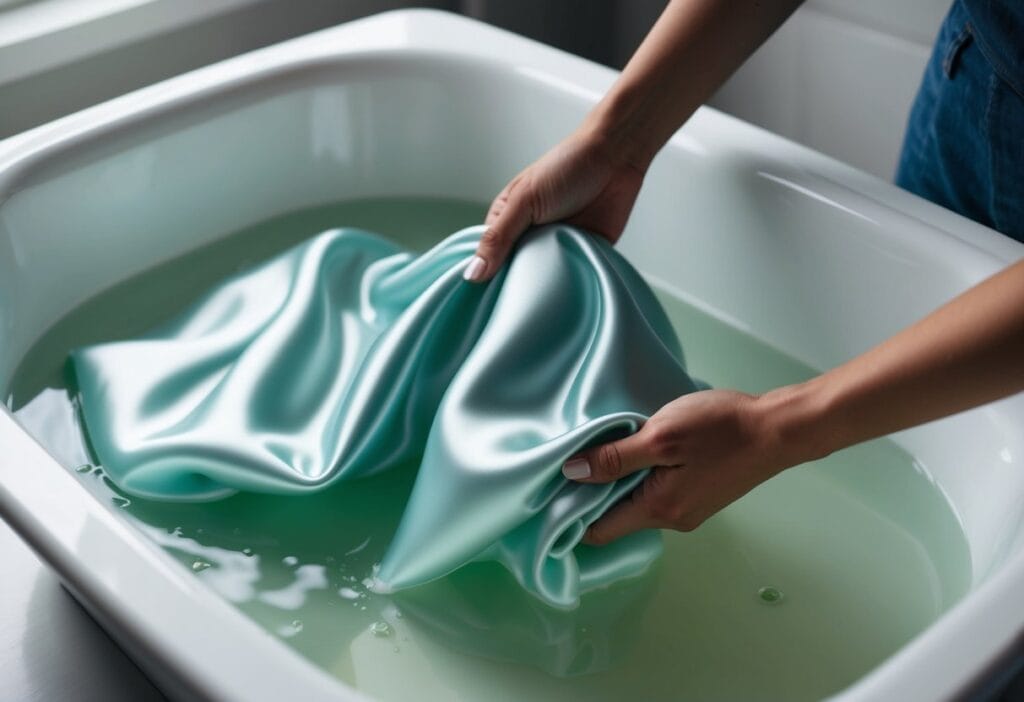From Luxurious Draping to Practical Applications: Understanding the Versatility of This Timeless Material
Satin fabric is known for its smooth, glossy surface and luxurious feel. This versatile material has been used for centuries in various applications, from elegant clothing to home décor. Satin is characterised by its unique weave structure, which creates a lustrous surface on one side and a duller finish on the other.
When shopping for satin, it’s important to note that it’s not a specific fibre type but rather a weaving technique. Satin can be made from various materials, including silk, polyester, and nylon. The choice of fibre affects the fabric’s properties, such as durability, cost, and care requirements.
Satin fabric offers a smooth, polished handle and luminous sheen that gives it an opulent appearance. Its lightweight drape and flow make it a popular choice for evening gowns and fancy dresses. However, satin can be delicate and may require special care to maintain its beauty and longevity.
On This Page
Key Takeaways
- Satin fabric is defined by its weave structure, not the fibre content
- The lustrous surface of satin gives it a luxurious appearance and feel
- Proper care is essential to maintain satin’s beauty and durability
The Basics of Satin Fabric
Satin fabric is known for its smooth, glossy surface and soft feel. It has a rich history and unique weaving method that sets it apart from other textiles.
Definition and Origins
Satin is a fabric characterised by its smooth, shiny finish. It’s not a specific material, but rather a type of weave that can be made from various fibres.
The term ‘satin’ refers to the weave structure, not the fibre content. This means satin can be made from silk, polyester, nylon, or other materials.
Satin has a long history dating back to ancient China. It was originally crafted from silk and was highly prized by the elite. Over time, its production spread to other parts of Asia and Europe.
Today, satin is used in a wide range of applications, from clothing to home furnishings.
Satin Weave Explained
The satin weave is what gives this fabric its distinctive look and feel. It’s created by floating warp yarns over weft yarns in a specific pattern.
In a basic satin weave:
- Warp threads pass over several weft threads before going under one
- This creates a smooth surface on one side of the fabric
- The back side typically has a duller appearance
The number of warp floats can vary, resulting in different types of satin weaves. For example, a 4-harness satin has warp threads floating over three weft threads.
This unique weave structure is what gives satin its lustrous appearance and soft texture. It also makes the fabric more durable than some other weave types.
Types and Varieties of Satin

Satin comes in many forms, each with unique qualities. The fabric’s shine and drape vary based on the fibres and weave used.
Silk Satin vs. Synthetic Satin
Silk satin is prized for its luxurious feel and natural sheen. It’s softer and more breathable than synthetic options. However, silk satin is pricier and requires delicate care.
Polyester satin is more affordable and durable. It’s easier to clean and resists wrinkles better than silk. But it may not drape as elegantly or feel as smooth against the skin.
Blended satins combine natural and synthetic fibres. These offer a balance of qualities from both materials.
Popular Variations of Satin Fabric
Charmeuse satin has a glossy front and matte back. It’s lightweight with a fluid drape, ideal for lingerie and evening wear.
Duchess satin is heavier and stiffer. Its structured feel makes it perfect for bridal gowns and formal attire.
Baronet satin uses cotton as the backing yarn. This creates a more casual look suitable for home décor.
Antique satin has a textured appearance. It’s often used for draperies and upholstery.
Each satin type offers unique benefits. Consider the fabric’s intended use when choosing the best variety for your needs.
Satin Fabric Characteristics

Satin fabric is known for its luxurious feel and appearance. It has a unique set of qualities that make it popular for various uses.
Texture and Feel
Satin has a smooth, shiny surface that feels soft to the touch. This glossy finish comes from the satin weave technique, which uses long floating yarns on the fabric’s surface.
The fabric drapes beautifully, giving it an elegant flow. Its sleek texture makes it comfortable against the skin, perfect for clothing and bedding.
Satin can be made from different fibres, including silk, polyester, or nylon. Each type affects the fabric’s feel slightly, but all maintain that signature smooth surface.
Durability and Maintenance
Satin’s durability varies depending on its fibre content. Silk satin is delicate and requires gentle care, while polyester satin is more robust.
Proper care is crucial for maintaining satin’s lustre. Hand washing or dry cleaning is often recommended to prevent damage.
Satin can be prone to snags and pulls, so careful handling is important. Avoid rough surfaces and sharp objects to keep the fabric looking its best.
Despite needing special care, well-maintained satin can last for years, retaining its beauty and shine.
Breathability and Comfort
Satin’s breathability depends on its fibre composition. Natural fibres like silk offer better air circulation than synthetic options.
The fabric’s smooth surface helps it glide over skin, reducing friction. This quality makes satin comfortable for sleepwear and bedding.
Satin tends to be cool to the touch, which can be pleasant in warm weather. However, it may not provide much warmth in colder conditions.
For those with sensitive skin, satin’s soft texture can be soothing and less likely to cause irritation compared to rougher fabrics.
Practical Uses of Satin Fabric

Satin fabric finds its way into many aspects of our daily lives. Its smooth texture and lustrous appearance make it a versatile material for various applications.
Fashion and Apparel
Satin shines in the world of fashion. Evening gowns and bridal dresses often feature satin fabric due to its elegant drape and sheen. Designers use it for:
- Formal wear
- Lingerie
- Blouses
- Skirts
- Ties
Its ability to catch light makes it a top choice for red carpet events. Satin also adds a touch of luxury to everyday wear like pyjamas and robes.
Many prefer satin for special occasions. Its smooth texture feels nice against the skin. The fabric’s flow creates graceful silhouettes in dresses and skirts.
Home Decor and Furnishings
Satin brings elegance to home interiors. Common uses include:
- Bedding (sheets, pillowcases, duvet covers)
- Curtains and drapes
- Throw pillows
- Table runners
- Upholstery for chairs and sofas
The fabric’s sheen can make a room feel more luxurious. Satin curtains, for example, can add a soft glow when light filters through them.
In bedrooms, satin sheets offer a cool, smooth surface. This can be quite comfy, especially in warm weather. The fabric’s lustre can also make a bed look more inviting.
Satin in Accessories and Crafts
Satin’s versatility extends to smaller items and DIY projects. Popular uses include:
- Hair accessories (scrunchies, headbands)
- Jewellery pouches
- Gift wrapping ribbons
- Decorative bows
- Handbags and clutches
Crafters often choose satin for its professional-looking finish. It’s great for making decorative flowers or adding accents to scrapbooks.
In the world of dance, satin is a top pick for ballet slippers. Its smooth surface allows dancers to glide across the floor with ease.
Caring for Satin Items

Proper care is key to keeping satin looking its best. With the right techniques, you can maintain the fabric’s lustrous sheen and soft feel for years to come.
Cleaning Satin Fabric
Washing satin requires gentle handling. Always check the care label first, as some items may need dry cleaning. For machine-washable satin, use cold water and a mild detergent. Place items in a mesh bag to prevent snags. Choose a delicate cycle and avoid spinning.
Hand-washing is often safest. Fill a basin with cool water and add a small amount of gentle soap. Swish the item gently and soak for 30 minutes. Rinse thoroughly with cool water until all soap is gone.
Never wring or twist satin. Instead, press out excess water by rolling the item in a clean towel. Lay flat to dry away from direct heat or sunlight.
Storing and Handling Satin
Proper storage keeps satin in top condition. Hang satin garments on padded hangers to prevent creases. For folded items, use acid-free tissue paper between layers to reduce friction.
Keep satin away from direct sunlight, which can fade the colour. Store in a cool, dry place to prevent mildew.
Handle satin with clean, dry hands to avoid transferring oils or dirt. Be careful with jewellery or rough surfaces that might snag the fabric.
Satin has some resistance to wrinkling, but ironing may sometimes be needed. Use a low heat setting and place a pressing cloth between the iron and fabric. Steam can also help remove light creases.
Satin in Fashion and Trends

Satin fabric has played a significant role in fashion history and continues to be a popular choice in current trends. Its smooth, glossy appearance and versatile nature make it a favourite for both clothing and home furnishings.
Satin’s Role in Fashion History
Satin has been a staple in fashion trends for centuries. It was once considered a luxury fabric reserved for royalty and the wealthy elite. In the early 20th century, satin became more accessible to the general public.
Evening gowns made of satin were particularly popular during the glamorous Hollywood era of the 1930s and 1940s. The fabric’s ability to drape beautifully and reflect light made it ideal for red carpet events.
Satin also gained prominence in lingerie design. Its soft, smooth texture against the skin made it a preferred choice for undergarments and nightwear.
Current Trends and Uses
Today, satin fabric is used in a wide range of fashion applications. Designers continue to incorporate satin into evening wear and formal attire. The fabric’s lustrous finish adds a touch of elegance to dresses, skirts, and blouses.
In recent years, satin has made a comeback in streetwear and casual fashion. Satin bomber jackets, trousers, and tops have become trendy items in many wardrobes.
Beyond clothing, satin has found its place in home furnishings. Satin pillowcases have gained popularity due to their purported benefits for skin and hair care. The smooth surface is believed to reduce friction and help prevent wrinkles and hair breakage.
Satin curtains and bedding continue to be sought after for their luxurious look and feel, adding a touch of opulence to interior decor.
Advantages and Challenges
Satin fabric offers a mix of benefits and drawbacks. Its luxurious look and feel make it a popular choice, but it requires special care.
Why Choose Satin?
Satin’s beautiful drape is one of its main selling points. The fabric flows elegantly, making it ideal for formal wear and home decor.
Satin is also quite versatile. It can be made from various fibres, including silk, polyester, and cotton. This means it can suit different budgets and needs.
The smooth texture of satin feels nice against the skin. Many people find it comfy for bedding and clothing.
Satin’s shiny surface catches the light, giving it a luxurious appearance. This makes it a top choice for special occasions.
Common Concerns and Mitigation
Despite its beauty, satin can be tricky to work with. It’s prone to snags and tears, so careful handling is a must.
Satin can be slippery, which makes sewing challenging. Using sharp scissors and pinning fabric carefully can help.
Some types of satin may not breathe well, which can be uncomfortable in warm weather. Choosing natural fibre satins can improve breathability.
Caring for satin often requires special attention. Many satin items need dry cleaning or gentle hand washing to maintain their appearance.
The cost of high-quality satin can be steep. However, more affordable options like polyester satin are available for those on a budget.
Purchasing Satin Fabric
Buying satin fabric requires careful thought. It’s important to consider quality, price, and sustainability when shopping for satin.
Considerations for Buying Satin
When looking to buy satin fabric, one should check its weight and drape. Heavier satin is better for dresses, while lighter satin works well for linings.
Fabric content matters too. Pure silk satin is pricey but luxurious. Polyester satin is cheaper and easier to care for.
Look at the sheen. A high lustre is great for formal wear, while a subtle sheen suits everyday items.
Colour is key. Satin shows dye well, so pick a shade that suits the project.
Price varies widely. Set a budget, but remember that higher quality often costs more.
Sustainable and Ethical Choices
Eco-friendly satin options are growing. Recycled polyester satin is a good choice for those wanting to reduce plastic waste.
Some brands offer organic silk satin. This is made without harmful pesticides.
Look for certifications like GOTS or Oeko-Tex. These ensure the fabric meets certain environmental standards.
Fair trade satin supports ethical labour practices. It may cost more, but it helps workers get fair wages.
Buying second-hand satin is another sustainable option. It gives new life to existing fabric and cuts waste.
Frequently Asked Questions
Satin fabric has unique qualities that set it apart from other materials. Let’s explore some common questions about its characteristics, uses, and varieties.
What are the defining characteristics of satin fabric?
Satin fabric is known for its smooth, glossy surface. It has a lustrous sheen on one side and a dull back. The fabric drapes well and feels soft to the touch.
How does satin fabric differ in use for trousers compared to dresses?
For trousers, satin is often used sparingly due to its slippery nature. It’s more commonly found in dress designs where its flowing quality enhances the garment’s elegance.
What are the possible drawbacks of using satin fabric?
Satin can be delicate and prone to snags. It may also show water stains easily. The fabric can be slippery to sew, making it challenging for inexperienced crafters.
Is satin fabric better suited for summer or winter attire?
Satin is versatile and can be worn year-round. Lighter satin works well for summer eveningwear, while heavier satin can be cosy in winter garments.
Can you describe the various types of satin fabric?
Satin fabric comes in several varieties. Charmeuse satin is lightweight and drapes well. Duchess satin is heavier and often used in bridal wear. Crepe-back satin has a textured reverse side.
How does one assess the quality of satin fabric?
Quality satin has a smooth, even surface without visible flaws. The sheen should be consistent, and the fabric should feel substantial. High-quality satin is often made from silk or fine synthetic fibres.
Related Post: Fabric 101: Essential Guide to Textiles and Materials

